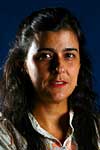

|
| Paula Johas |

How news and journalism is delivered in future is going to be of vital importance to photographers, whether it is online or on paper.
Paula Johas is a photo editor with the Brazilian newspaper OGlobo
and says online news will continue to develop but the printed newspaper will
still have its place.
(This article was prepared with the assistance of Alexandre Sassaki and websites linked to from this article are in Portuguese.)
"On the Internet, news is free and there is more choice. But the future
is good on the printed page too. I am optimistic about the future of printed
photojournalism when adapted to the digital era.
On paper, we can read longer items to be digested at leisure, and there is often a different approach to the content.
The best photography will not only be factual. On the web, readers could display their own images. But photos taken with proper lighting, framing and creative composition will be increasingly part of the printed news.
Whatever the medium of delivery platform, journalism all begins with reporters, photographers and editors who can recognize, capture and tell a good story.
Without them, technological issues do not matter. Not everyone can turn facts into news and awaken the reader's interest.
But the world of information has changed. Editorial staff integration, a greater use of multimedia resources, the dissemination of blogs and "citizen-journalism" (in which the reader contributes with news and images) are gaining importance.
But there's a huge difference between collaboration and turning out an entire journal. Interaction with the reader can increase participation in production but collaborators are not necessarily capable of turning facts into news.
The same logic applies to in photojournalism. Quantity is no substitute for quality.
Professional specialists can end up being forced to turn into "multimedia reporters". But saving money may mean fewer profits in future if standards drop.
Convergence is probably one answer. Articles can be commissioned from journalists
with more than one platform in mind. Globo
Online, for instance, offers workshops in the use of video cameras to reporters
and photographers – multi-skilling in action.
In my opinion, it's hard for a single person to use many mediums simultaneously
to produce a single, quality report. According to Lourival Sant'Anna, in O
Destino do Jornal (The newspaper's destiny); "This kind of practice
does not work in our current environments. The journalists aren't multimedia
but the editorial staff is. A photographer, a cameraman and a text reporter
are very different. We need a professional for each function."
But multi-media means the photojournalist can begin to tell stories without the limitations imposed by paper and page layouts. Photography has a great future in multimedia. Photo galleries, one of the most successful developments on the Internet, are proof of that.
Can photojournalism be improved with the use of video and vice versa? The languages are different but complementary. Videos suit certain stories, still photojournalism others. Several articles published in printed newspapers arise from the efforts of photo reporters.
But whatever the medium, photos still matter. Newspaper design communicates the character of the publication and photography is of huge importance to this. Images make a difference to how a paper or magazine looks and attracts readers.
The same is true in different ways on the Internet. And as technology continues to improve, the uses to which it can be put online will diversify.
In either case, the future of photojournalism looks good."
|